TOYOTA RAV4 2009 XA30 / 3.G Owners Manual
Manufacturer: TOYOTA, Model Year: 2009, Model line: RAV4, Model: TOYOTA RAV4 2009 XA30 / 3.GPages: 516, PDF Size: 10.61 MB
Page 471 of 516
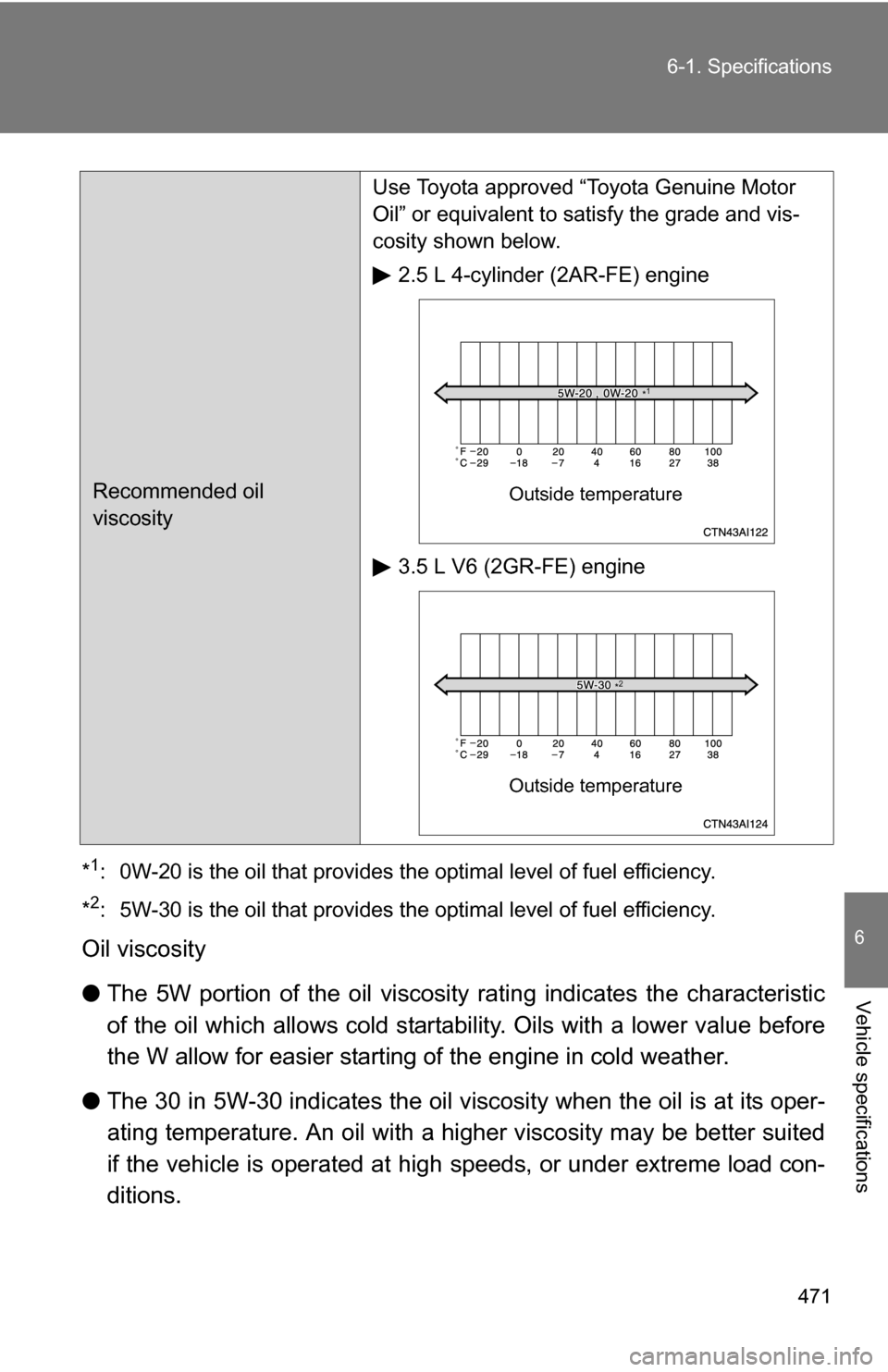
471
6-1. Specifications
6
Vehicle specifications
*1: 0W-20 is the oil that provides the optimal level of fuel efficiency.
*
2: 5W-30 is the oil that provides the optimal level of fuel efficiency.
Oil viscosity
● The 5W portion of the oil viscosity rating indicates the characteristic
of the oil which allows cold startab ility. Oils with a lower value before
the W allow for easier starting of the engine in cold weather.
● The 30 in 5W-30 indicates the oil viscosity when the oil is at its oper-
ating temperature. An oil with a higher viscosity may be better suited
if the vehicle is operated at high speeds, or under extreme load con-
ditions.
Recommended oil
viscosity Use Toyota approved “Toyota Genuine Motor
Oil” or equivalent to satisfy the grade and vis-
cosity shown below.
2.5 L 4-cylinder (2AR-FE) engine
3.5 L V6 (2GR-FE) engineOutside temperature
*1
Outside temperature
*2
Page 472 of 516
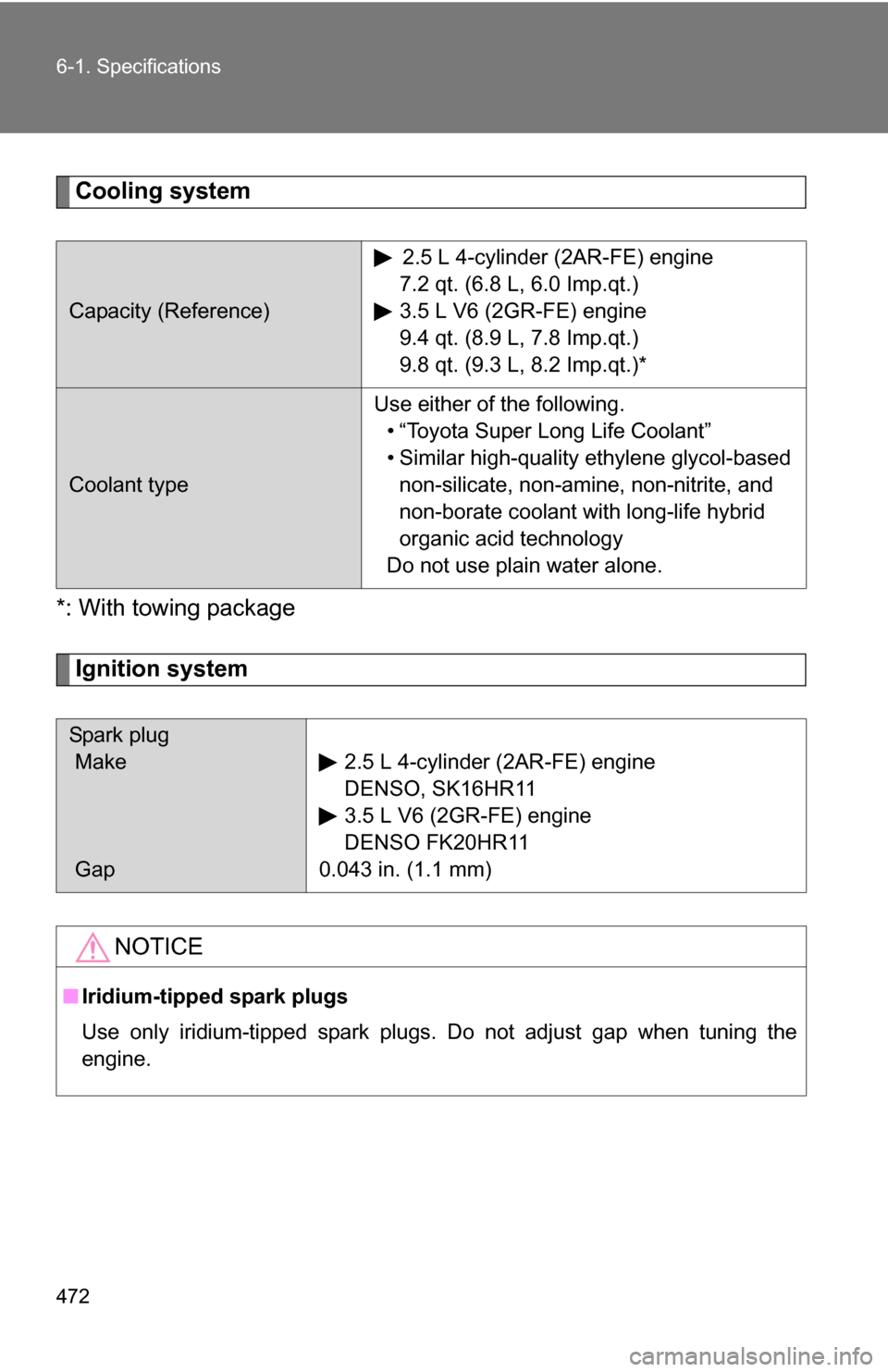
472 6-1. Specifications
Cooling system
*: With towing package
Ignition system
Capacity (Reference) 2.5 L 4-cylinder (2AR-FE) engine
7.2 qt. (6.8 L, 6.0 Imp.qt.)
3.5 L V6 (2GR-FE) engine
9.4 qt. (8.9 L, 7.8 Imp.qt.)
9.8 qt. (9.3 L, 8.2 Imp.qt.)*
Coolant type Use either of the following.
• “Toyota Super Long Life Coolant”
• Similar high-quality ethylene glycol-based non-silicate, non-amine, non-nitrite, and
non-borate coolant with long-life hybrid
organic acid technology
Do not use plain water alone.
Spark plug
Make
Gap 2.5 L 4-cylinder (2AR-FE) engine
DENSO, SK16HR11
3.5 L V6 (2GR-FE) engine
DENSO FK20HR11
0.043 in. (1.1 mm)
NOTICE
■ Iridium-tipped spark plugs
Use only iridium-tipped spark plugs. Do not adjust gap when tuning the
engine.
Page 473 of 516
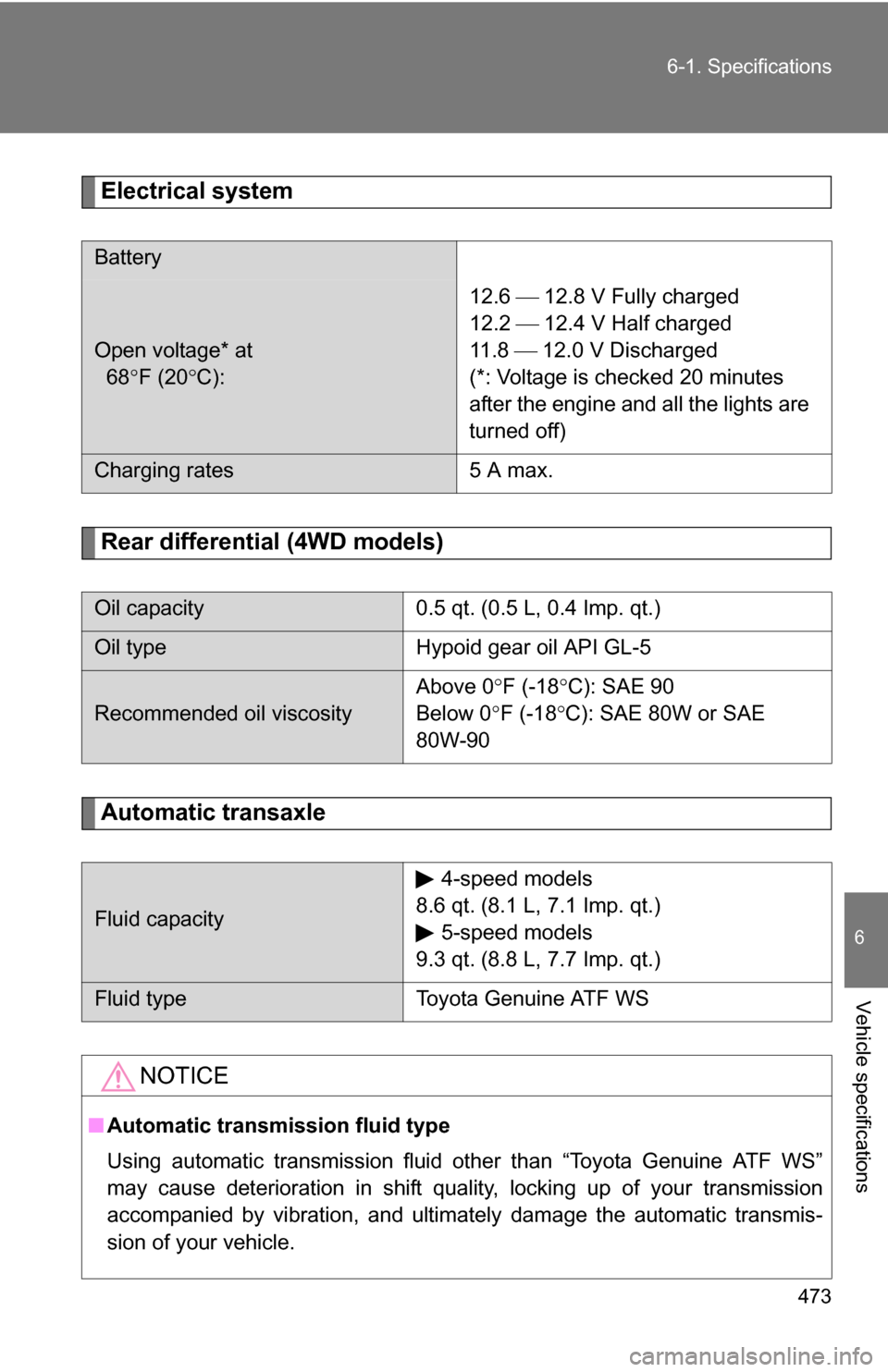
473
6-1. Specifications
6
Vehicle specifications
Electrical system
Rear differential (4WD models)
Automatic transaxle
Battery
Open voltage* at
68
F (20 C): 12.6 12.8 V Fully charged
12.2 12.4 V Half charged
11 . 8
12.0 V Discharged
(*: Voltage is checked 20 minutes
after the engine and all the lights are
turned off)
Charging rates 5 A max.
Oil capacity0.5 qt. (0.5 L, 0.4 Imp. qt.)
Oil typeHypoid gear oil API GL-5
Recommended oil viscosityAbove 0
F (-18 C): SAE 90
Below 0 F (-18 C): SAE 80W or SAE
80W-90
Fluid capacity 4-speed models
8.6 qt. (8.1 L, 7.1 Imp. qt.) 5-speed models
9.3 qt. (8.8 L, 7.7 Imp. qt.)
Fluid type Toyota Genuine ATF WS
NOTICE
■Automatic transmission fluid type
Using automatic transmission fluid other than “Toyota Genuine ATF WS”
may cause deterioration in shift quality, locking up of your transmission
accompanied by vibration, and ultimately damage the automatic transmis-
sion of your vehicle.
Page 474 of 516
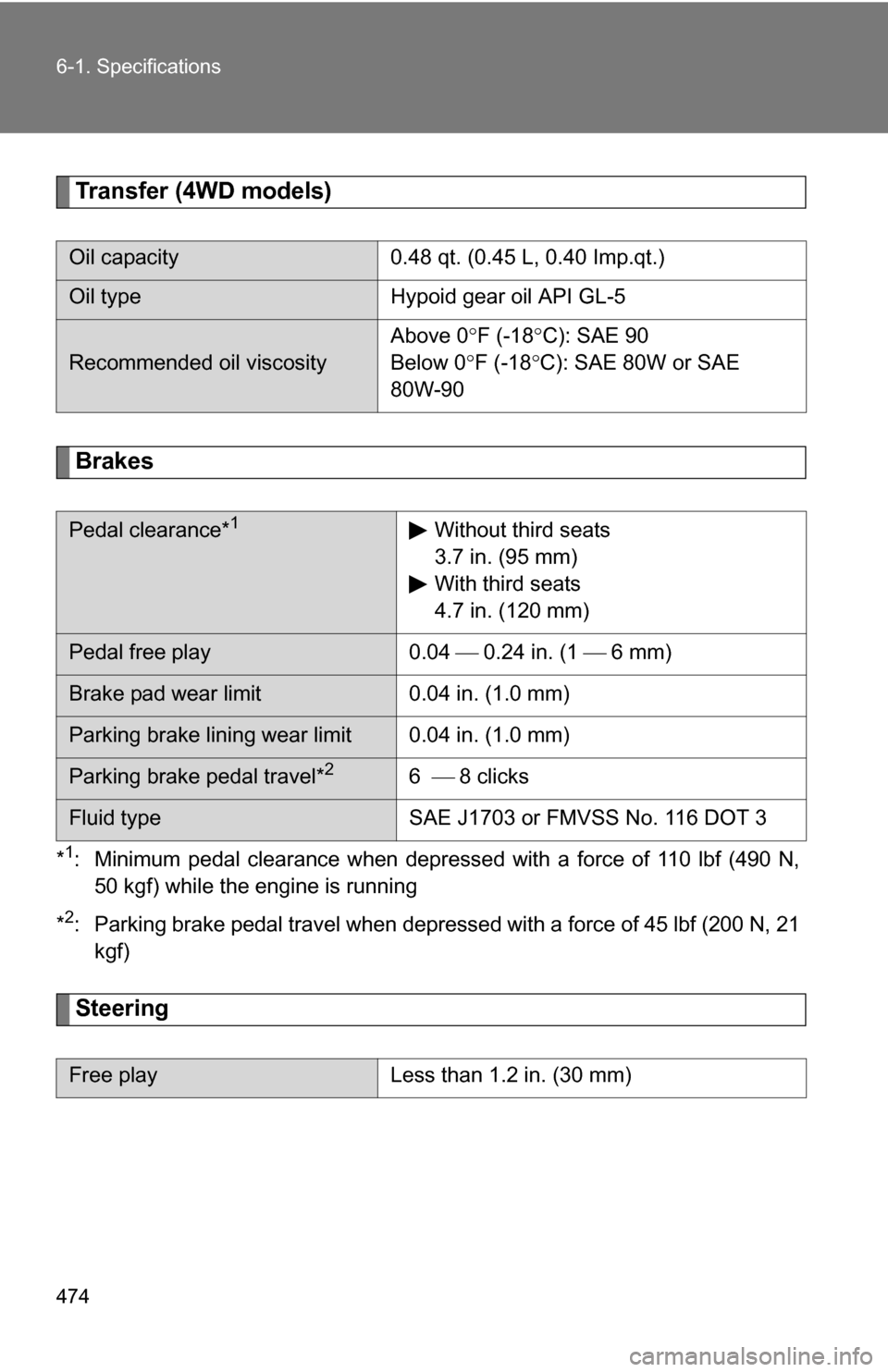
474 6-1. Specifications
Transfer (4WD models)
Brakes
*1: Minimum pedal clearance when depressed with a force of 110 lbf (490 N,50 kgf) while the engine is running
*
2: Parking brake pedal travel when depressed with a force of 45 lbf (200 N, 21 kgf)
Steering
Oil capacity 0.48 qt. (0.45 L, 0.40 Imp.qt.)
Oil typeHypoid gear oil API GL-5
Recommended oil viscosityAbove 0
F (-18 C): SAE 90
Below 0 F (-18 C): SAE 80W or SAE
80W-90
Pedal clearance*1Without third seats
3.7 in. (95 mm)
With third seats
4.7 in. (120 mm)
Pedal free play 0.04 0.24 in. (1 6 mm)
Brake pad wear limit 0.04 in. (1.0 mm)
Parking brake lining wear limit 0.04 in. (1.0 mm)
Parking brake pedal travel*26 8 clicks
Fluid type SAE J1703 or FMVSS No. 116 DOT 3
Free playLess than 1.2 in. (30 mm)
Page 475 of 516
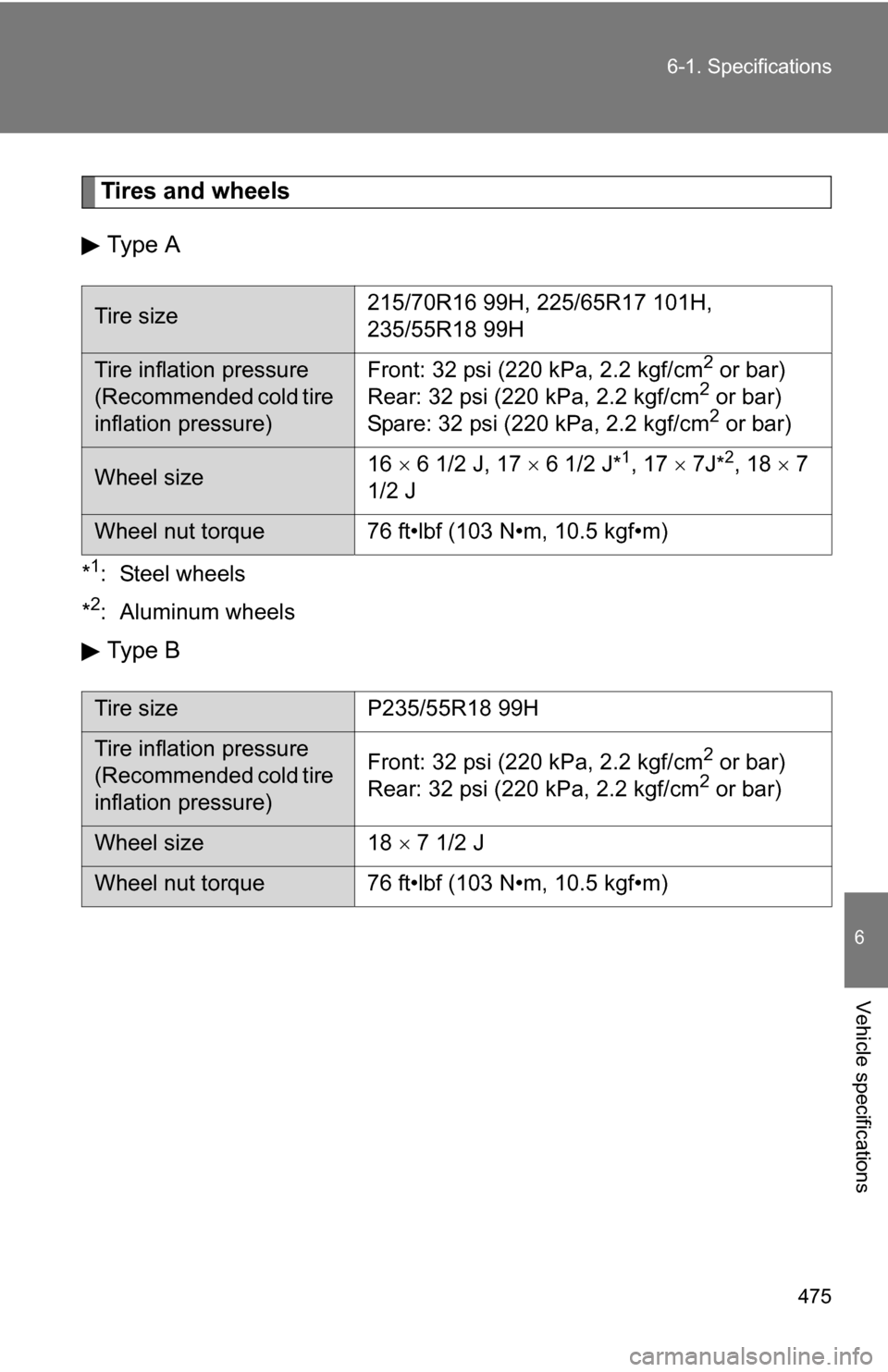
475
6-1. Specifications
6
Vehicle specifications
Tires and wheels
Type A
*1: Steel wheels
*
2: Aluminum wheels
Type B
Tire size 215/70R16 99H, 225/65R17 101H,
235/55R18 99H
Tire inflation pressure
(Recommended cold tire
inflation pressure)Front: 32 psi (220 kPa, 2.2 kgf/cm2 or bar)
Rear: 32 psi (220 kPa, 2.2 kgf/cm2 or bar)
Spare: 32 psi (220 kPa, 2.2 kgf/cm2 or bar)
Wheel size 16
6 1/2 J, 17 6 1/2 J*1, 17 7J*2, 18 7
1/2 J
Wheel nut torque 76 ft•lbf (103 N•m, 10.5 kgf•m)
Tire size P235/55R18 99H
Tire inflation pressure
(Recommended cold tire
inflation pressure) Front: 32 psi (220 kPa, 2.2 kgf/cm2 or bar)
Rear: 32 psi (220 kPa, 2.2 kgf/cm2 or bar)
Wheel size 18 7 1/2 J
Wheel nut torque 76 ft•lbf (103 N•m, 10.5 kgf•m)
Page 476 of 516
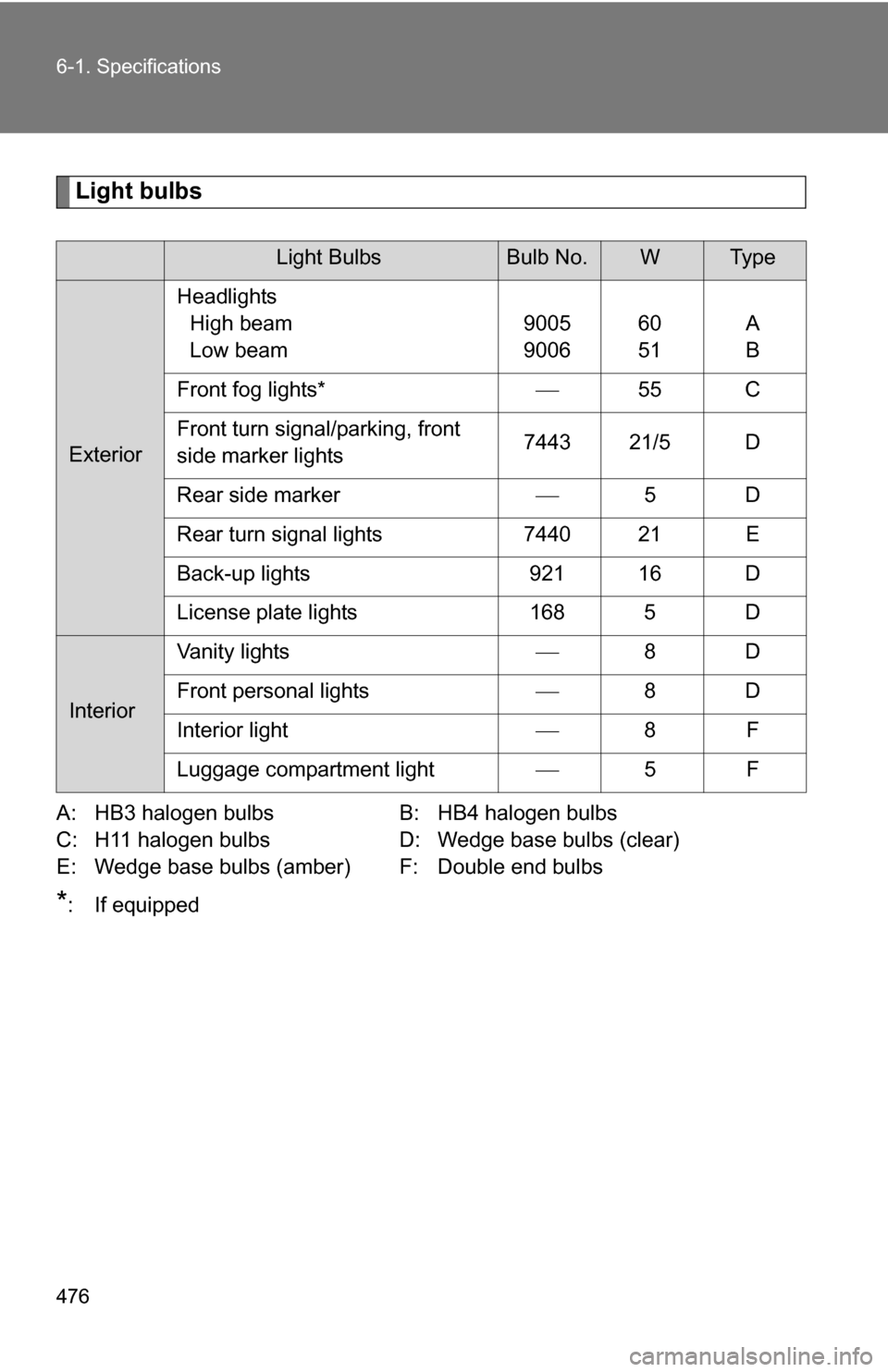
476 6-1. Specifications
Light bulbs
A: HB3 halogen bulbsB: HB4 halogen bulbs
C: H11 halogen bulbs D: Wedge base bulbs (clear)
E: Wedge base bulbs (amber) F: Double end bulbs
*: If equipped
Light BulbsBulb No.WTy p e
Exterior Headlights
High beam
Low beam 9005
900660
51A
B
Front fog lights* 55 C
Front turn signal/parking, front
side marker lights 7443 21/5 D
Rear side marker 5D
Rear turn signal lights 7440 21 E
Back-up lights 921 16 D
License plate lights 168 5 D
Interior Vanity lights
8D
Front personal lights 8D
Interior light 8F
Luggage compartment light 5F
Page 477 of 516
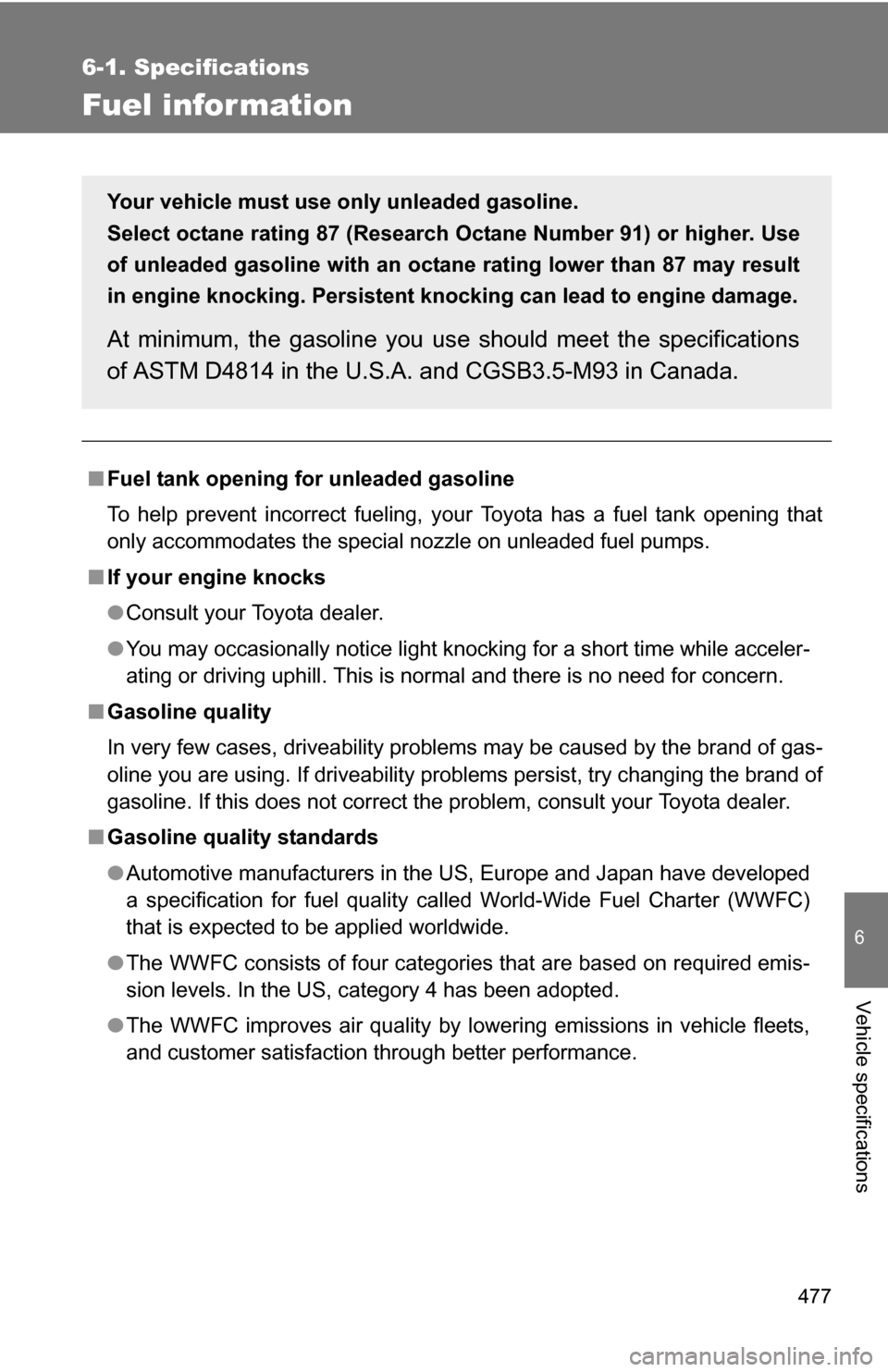
477
6-1. Specifications
6
Vehicle specifications
Fuel infor mation
■Fuel tank opening fo r unleaded gasoline
To help prevent incorrect fueling, your Toyota has a fuel tank opening that
only accommodates the special nozzle on unleaded fuel pumps.
■ If your engine knocks
●Consult your Toyota dealer.
● You may occasionally notice light knocking for a short time while acceler-
ating or driving uphill. This is normal and there is no need for concern.
■ Gasoline quality
In very few cases, driveability problems may be caused by the brand of gas-
oline you are using. If driveability problems persist, try changing the brand of
gasoline. If this does not correct the problem, consult your Toyota dealer.
■ Gasoline quality standards
●Automotive manufacturers in the US, Europe and Japan have developed
a specification for fuel quality called World-Wide Fuel Charter (WWFC)
that is expected to be applied worldwide.
● The WWFC consists of four categories that are based on required emis-
sion levels. In the US, category 4 has been adopted.
● The WWFC improves air quality by lowering emissions in vehicle fleets,
and customer satisfaction through better performance.
Your vehicle must use only unleaded gasoline.
Select octane rating 87 (Research Octane Number 91) or higher. Use
of unleaded gasoline with an octane rating lower than 87 may result
in engine knocking. Persistent kno cking can lead to engine damage.
At minimum, the gasoline you use should meet the specifications
of ASTM D4814 in the U.S.A. and CGSB3.5-M93 in Canada.
Page 478 of 516
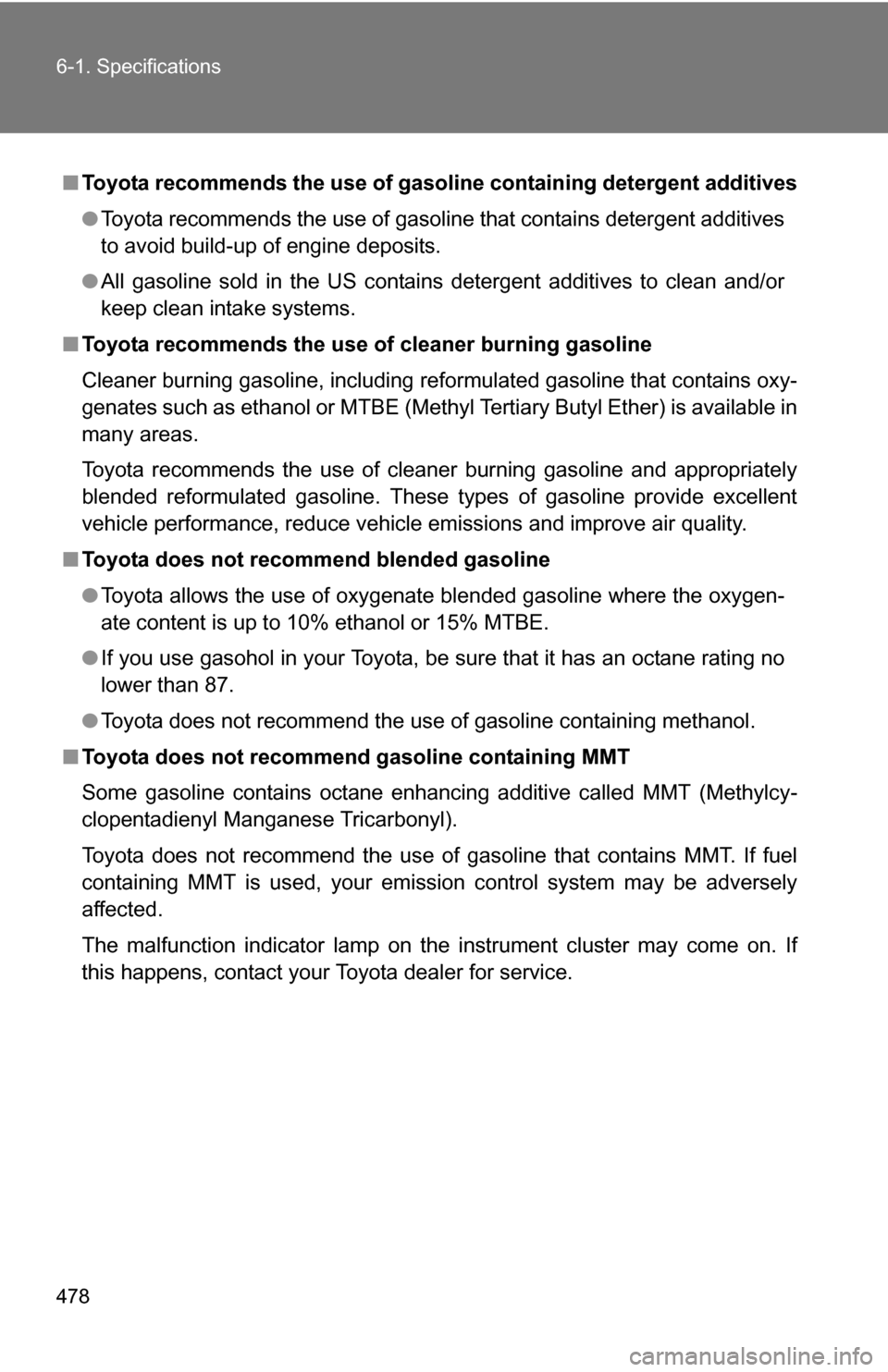
478 6-1. Specifications
■Toyota recommends the use of gaso line containing detergent additives
● Toyota recommends the use of gasoline that contains detergent additives
to avoid build-up of engine deposits.
● All gasoline sold in the US contains detergent additives to clean and/or
keep clean intake systems.
■ Toyota recommends the use of cleaner burning gasoline
Cleaner burning gasoline, including reformulated gasoline that contains oxy-
genates such as ethanol or MTBE (Methyl Tertiary Butyl Ether) is available in
many areas.
Toyota recommends the use of cleaner burning gasoline and appropriately
blended reformulated gasoline. These types of gasoline provide excellent
vehicle performance, reduce vehicle emissions and improve air quality.
■ Toyota does not recomm end blended gasoline
● Toyota allows the use of oxygenate blended gasoline where the oxygen-
ate content is up to 10% ethanol or 15% MTBE.
● If you use gasohol in your Toyota, be sure that it has an octane rating no
lower than 87.
● Toyota does not recommend the use of gasoline containing methanol.
■ Toyota does not recommen d gasoline containing MMT
Some gasoline contains octane enhancing additive called MMT (Methylcy-
clopentadienyl Manganese Tricarbonyl).
Toyota does not recommend the use of gasoline that contains MMT. If fuel
containing MMT is used, your emission control system may be adversely
affected.
The malfunction indicator lamp on the instrument cluster may come on. If
this happens, contact your Toyota dealer for service.
Page 479 of 516
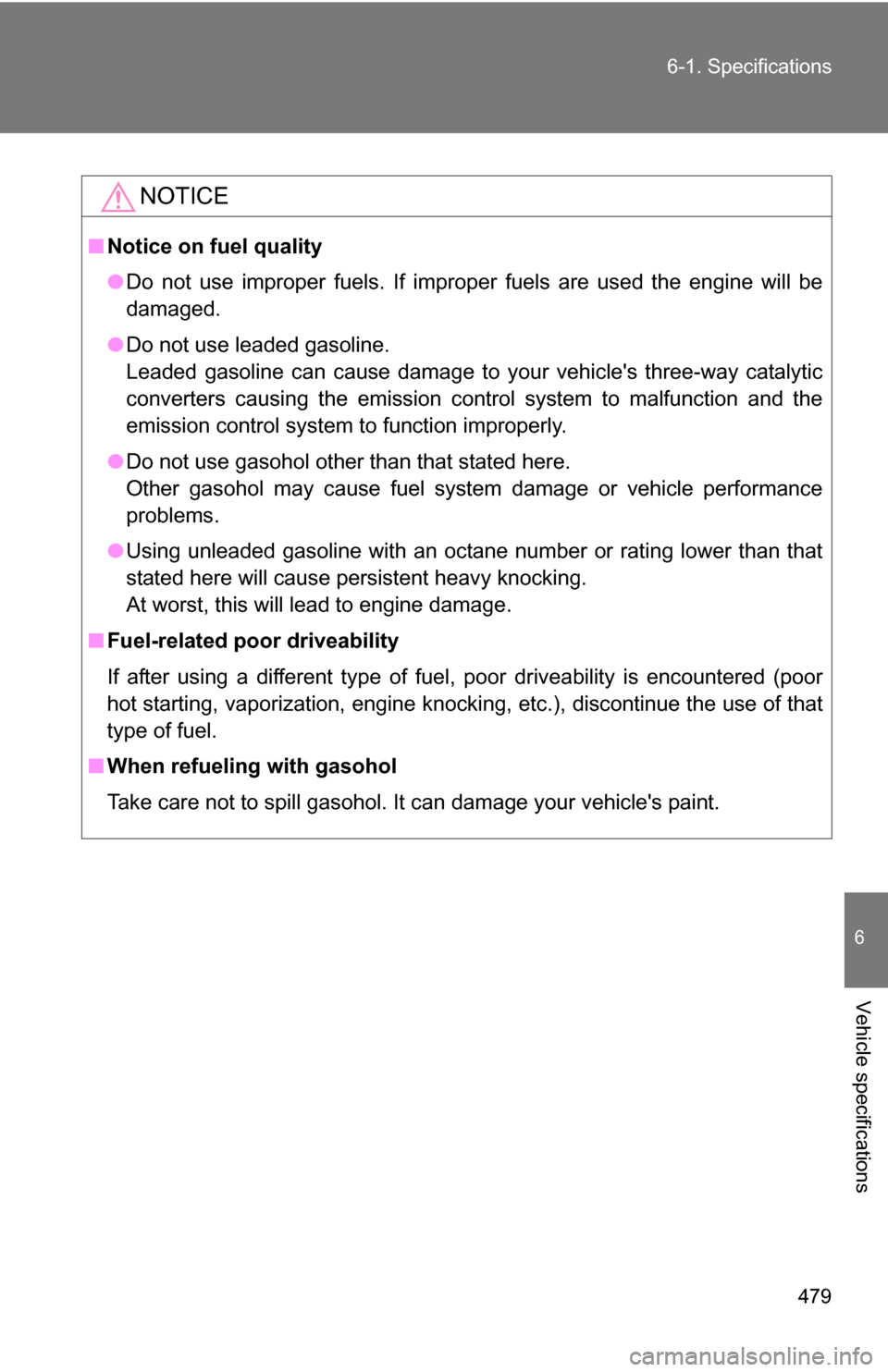
479
6-1. Specifications
6
Vehicle specifications
NOTICE
■
Notice on fuel quality
●Do not use improper fuels. If improper fuels are used the engine will be
damaged.
● Do not use leaded gasoline.
Leaded gasoline can cause damage to your vehicle's three-way catalytic
converters causing the emission control system to malfunction and the
emission control system to function improperly.
● Do not use gasohol other than that stated here.
Other gasohol may cause fuel system damage or vehicle performance
problems.
● Using unleaded gasoline with an octane number or rating lower than that
stated here will cause persistent heavy knocking.
At worst, this will lead to engine damage.
■ Fuel-related poor driveability
If after using a different type of fuel, poor driveability is encountered (poor
hot starting, vaporization, engine knocking, etc.), discontinue the use of that
type of fuel.
■ When refueling with gasohol
Take care not to spill gasohol. It can damage your vehicle's paint.
Page 480 of 516
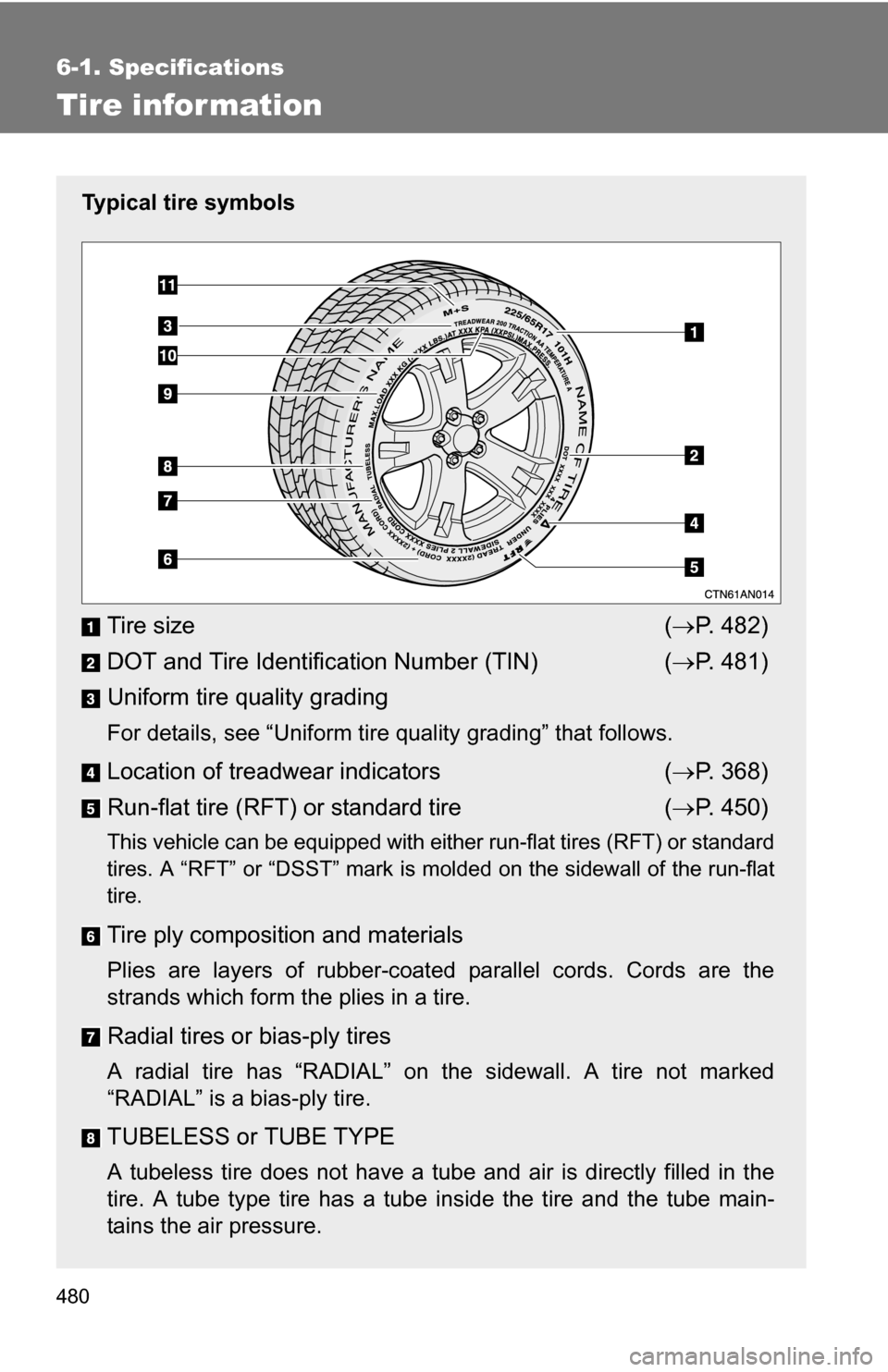
480
6-1. Specifications
Tire infor mation
Typical tire symbols
Tire size( P. 482)
DOT and Tire Identification Number (TIN) ( P. 481)
Uniform tire quality grading
For details, see “Uniform tire quality grading” that follows.
Location of treadwear indicators ( P. 368)
Run-flat tire (RFT) or standard tire ( P. 450)
This vehicle can be equipped with either run-flat tires (RFT) or standard
tires. A “RFT” or “DSST” mark is molded on the sidewall of the run-flat
tire.
Tire ply composition and materials
Plies are layers of rubber-coated parallel cords. Cords are the
strands which form the plies in a tire.
Radial tires or bias-ply tires
A radial tire has “RADIAL” on the sidewall. A tire not marked
“RADIAL” is a bias-ply tire.
TUBELESS or TUBE TYPE
A tubeless tire does not have a tube and air is directly filled in the
tire. A tube type tire has a tube inside the tire and the tube main-
tains the air pressure.